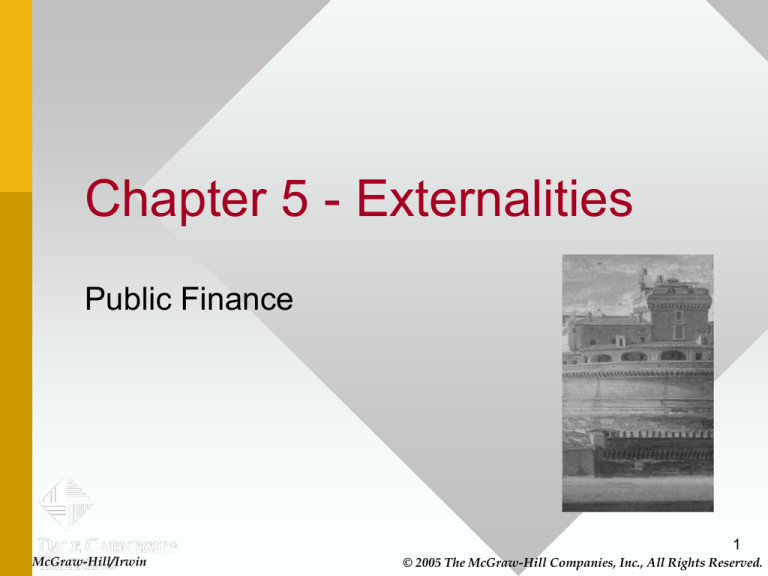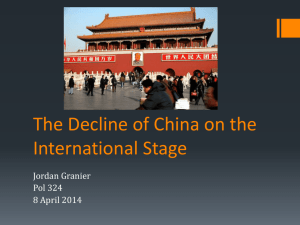
Chapter 5 - Externalities
Public Finance
1
McGraw-Hill/Irwin
© 2005 The McGraw-Hill Companies, Inc., All Rights Reserved.
Externality Defined
• An externality is present when the activity of
one entity (person or firm) directly affects the
welfare of another entity in a way that is outside
the market mechanism.
– Negative externality: These activities impose
damages on others.
– Positive externality: These activities benefits on
others.
2
Examples of Externalities
•
Negative Externalities
•
–
–
–
–
–
Pollution
Cell phones in a movie theater
Congestion on the internet
Drinking and driving
Student cheating that changes
the grade curve
– The “Club” anti-theft device for
automobiles
Positive Externalities
–
–
–
–
Research & development
Vaccinations
A neighbor’s nice landscape
Students asking good questions
in class
– The “LoJack” anti-theft device
for automobiles
•
Not Considered Externalities
– Land prices rising in urban area
– Known as “pecuniary”
externalities
3
Nature of Externalities
• Arise because there is no market price attached
to the activity
• Can be produced by people or firms
• Can be positive or negative
• Public goods are special case
– Positive externality’s full effects are felt by everyone
in the economy
4
Graphical Analysis:
Negative Externalities
• For simplicity, assume that a steel firm dumps
pollution into a river that harms a fishery
downstream.
• Competitive markets, firms maximize profits
– Note that steel firm only cares about its own profits,
not the fishery’s profits.
– Fishery only cares about its profits, not the steel
firm’s profits.
5
Graphical Analysis, continued
• MB = marginal benefit to steel firm
• MPC = marginal private cost to steel firm
• MD = marginal damage to fishery
• MSC = MPC+MD = marginal social cost
6
Figure 5.1
Graphical Analysis, continued
• From Figure 5.1, as usual, the steel firm
maximizes profits at MB=MPC. This
quantity is denoted as Q1 in the figure.
• Social welfare is maximized at MB=MSC,
which is denoted as Q* in the figure.
8
Graphical Analysis, Implications
• Result 1: Q1>Q*
– Steel firm privately produces “too much” steel, because it
does not account for the damages to the fishery.
• Result 2: Fishery’s preferred amount is 0.
– Fishery’s damages are minimized at MD=0.
• Result 3: Q* is not the preferred quantity for either party,
but is the best compromise between fishery and steel firm.
• Result 4: Socially efficient level entails some pollution.
– Zero pollution is not socially desirable.
9
Figure 5.2
Graphical Analysis, Intuition
• In Figure 5.2, loss to steel firm of moving to Q* is
shaded triangle dcg.
– This is the area between the MB and MPC curve
going from Q1 to Q*.
• Fishery gains by an amount abfe.
– This is the area under the MD curve going from Q1 to
Q*. By construction, this equals area cdhg.
• Difference between fishery’s gain and steel firm’s
loss is the efficiency loss from producing Q1 instead
of Q*.
11
Numerical Example:
Negative Externalities
• Assume the steel firm faces the following MB and MPC
curves:
MB 300 Q
MPC 20 Q
• Assume the fishery faces the following MD curve:
MD 40 2Q
12
Numerical Example, continued
• The steel firm therefore chooses Q1:
MB MPC 300 Q 20 Q Q1 140
• The socially efficient amount is instead Q*:
MB MSC MPC MD
300 Q 20 Q 40 2Q Q * 60
13
Numerical Example, continued
•
The deadweight loss of steel firm choosing Q1=140 is calculated as
the triangle between the MB and MSC curves from Q1 to Q*.
1
Q1 Q * MSC Q1 MB Q1
2
1
DWL 140 60480 160 $12800
2
DWL
•
In Figure 5.2, this corresponds to area dhg.
14
Numerical Example, continued
•
By moving to Q* the fishery reduces its damages by an amount equal
to the trapezoid under the MD curve from Q1 to Q*.
1
GAIN Q1 Q * MD Q* MD Q1
2
1
GAIN 140 60160 320 19200
2
•
By moving to Q* the steel firm loses profits equal to the triangle
between the MB and MPC curve from Q1 to Q*.
1
LOSS Q1 Q * MB Q* MC Q*
2
1
LOSS 140 60240 80 $6400
2
15
Calculating Gains & Losses
Raises Practical Questions
• What activities produce pollutants?
– With acid rain it is not known how much is associated with
factory production versus natural activities like plant decay.
• Which pollutants do harm?
– Pinpointing a pollutant’s effect is difficult. Some studies
show very limited damage from acid rain.
• What is the value of the damage done?
– Difficult to value because pollution not bought/sold in
market. Housing values may capitalize in pollution’s
effect.
16
Private Responses
• Coase Theorem
• Mergers
• Social conventions
17
Coase Theorem
• Insight: root of the inefficiencies from
externalities is the absence of property rights.
• The Coase Theorem states that once property
rights are established and transaction costs are
small, then one of the parties will bribe the
other to attain the socially efficient quantity.
• The socially efficient quantity is attained
regardless of to whom the property rights were
initially assigned.
18
Illustration of the Coase Theorem
• Recall the steel firm/fishery example. If the
steel firm were assigned property rights, it
would initially produce Q1, which maximizes
its profits.
• If the fishery were assigned property rights, it
would initially mandate zero production,
which minimizes its damages.
19
Figure 5.3
Coase Theorem:
Assign Property Rights to Steel Firm
• Consider the effects of the steel firm reducing production
in the direction of the socially efficient level, Q*. This
entails a cost to the steel firm and a benefit to the
fishery:
– The steel firm (and its customers) would lose surplus
between the MB and MPC curves between Q1 and Q1-1,
while the fishery’s damages are reduced by the area under
the MD curve between Q1 and Q1-1.
– Note that the marginal loss in profits is extremely small,
because the steel firm was profit maximizing, while the
reduction in damages to the fishery is substantial.
– A bribe from the fishery to the steel firm could therefore
make all parties better off.
21
Coase Theorem:
Assign Property Rights to Steel Firm
• When would the process of bribes (and pollution
reduction) stop?
– When the parties no longer find it beneficial to bribe.
– The fishery will not offer a bribe larger than its MD for a
given quantity, and the steel firm will not accept a bribe
smaller than its loss in profits (MB-MPC) for a given
quantity.
– Thus, the quantity where MD=(MB-MPC) will be where the
parties stop bribing and reducing output.
– Rearranging, MC+MPC=MB, or MSC=MB, which is equal
at Q*, the socially efficient level.
22
Coase Theorem:
Assign Property Rights to Fishery
• Similar reasoning follows when the fishery has property
rights, and initially allows zero production.
– The fishery’s damages are increased by the area under
the MD curve by moving from 0 to 1. On the other hand,
the steel firm’s surplus is increased.
– The increase in damages to the fishery is initially very
small, while the gain in surplus to the steel firm is large.
– A bribe from the steel firm to the fishery could therefore
make all parties better off.
23
Coase Theorem:
Assign Property Rights to Fishery
• When would the process of bribes now stop?
– Again, when the parties no longer find it beneficial to
bribe.
– The fishery will not accept a bribe smaller than its
MD for a given quantity, and the steel firm will not
offer a bribe larger than its gain in profits (MB-MPC)
for a given quantity.
– Again, the quantity where MD=(MB-MPC) will be
where the parties stop bribing and reducing output.
This still occurs at Q*.
24
When Is the Coase Theorem Relevant?
• Low transaction
costs
– Few parties involved
• Source of externality
well defined
• Not relevant with high
transaction costs or
ill-defined externality
• Example: Air pollution
• Example: Several
firms with pollution
25
Private Responses, continued
• Mergers
• Social conventions
26
Mergers
• Mergers between firms “internalize” the
externality.
• A firm that consisted of both the steel firm and
fishery would only care about maximizing the
joint profits of the two firms, not either’s profits
individually.
• Thus, it would take into account the effects of
increased steel production on the fishery.
27
Social Conventions
• Certain social conventions can be viewed as
attempts to force people to account for the
externalities they generate.
• Examples include conventions about not
littering, not talking in a movie theater, etc.
28
Public Responses
• Taxes
• Subsidies
• Creating a market
• Regulation
29
Taxes
• Again, return to the steel firm/fishery example.
• Steel firm produces inefficiently because the
prices for inputs incorrectly signal social costs.
Input prices are too low. Natural solution is to
levy a tax on a polluter.
• A Pigouvian tax is a tax levied on each unit of
a polluter’s output in an amount just equal to
the marginal damage it inflicts at the efficient
level of output.
30
Figure 5.4
Taxes
• This tax clearly raises the cost to the steel firm
and will result in a reduction of output.
• Will it achieve a reduction to Q*?
– With the tax, t, the steel firm chooses quantity such that
MB=MPC+t.
– When the tax is set to equal the MD evaluated at Q*, the
expression becomes MB=MPC+MD(Q*).
– Graphically, it is clear that MB(Q*)-MPC(Q*)=MD(Q*),
thus the firm produces the efficient level.
32
Numerical Example: Pigouvian Taxes
• Returning to the numerical example:
MB 300 Q
MPC 20 Q
MD 40 2Q
• Recall that Q1=140 and Q*=60.
33
Numerical Example: Pigouvian Taxes
• Setting t=MD(60) gives t=160. The firm now sets
MB=MPC+t, which then yields Q*.
MB MPC t
300 Q 20 Q t
300 Q 20 Q 160
120 2Q
Q 60
34
Public Responses
• Subsidies
• Creating a market
• Regulation
35
Subsidies
• Another solution is paying the polluter to not pollute.
• Assume this subsidy was again equal to the marginal
damage at the socially efficient level.
• Steel firm would cut back production until the loss in
profit was equal to the subsidy; this again occurs at Q*.
• Subsidy could induce new firms to enter the market,
however.
36
Public Responses
• Creating a market
• Regulation
37
Creating a Market
• Sell producers permits to pollute. Creates
market that would not have emerged.
• Process:
– Government sells permits to pollute in the quantity Z*.
– Firms bid for the right to own these permits, fee
charged clears the market.
• In effect, supply of permits is inelastic.
38
Figure 5.6
Creating a Market, continued
• Process would also work if the government
initially assigned permits to firms, and then
allowed firms to sell permits.
– Distributional consequences are different – firms that
are assigned permits initially now benefit.
• One advantage over Pigouvian taxes: permit
scheme reduces uncertainty over ultimate
level of pollution when costs of MB, MPC, and
MD are unknown.
40
Public Responses
• Regulation
41
Regulation
• Each polluter must reduce pollution by a certain
amount or face legal sanctions.
• Inefficient when there are multiple firms with
different costs to pollution reduction. Efficiency
does not require equal reductions in pollution
emissions; rather, it depends on the shapes of
the MB and MPC curves.
42
Figure 5.7
The U.S. Response
• 1970s: Regulation
– Congress set national air quality standards that were
to be met independent of the costs of doing so.
• 1990s: Market oriented approaches have
somewhat more influence, but not dominant.
– 1990 Clean Air Act created a market to control
emissions of sulfur dioxide with permits.
44
Graphical Analysis:
Positive Externalities
• For simplicity, assume that a university
conducts research that has spillovers to a
private firm.
• Competitive markets, firms maximize profits
– Note that university only cares about its own profits,
not the private firm’s profits.
– Private firm only cares about its profits, not the
university’s profits.
45
Graphical Analysis, continued
• MPB = marginal private benefit to university
• MC = marginal cost to university
• MEB = marginal external benefit to private firm
• MSB = MPB+MEB = marginal social benefit
46
Figure 5.8
Graphical Analysis, continued
• From Figure 5.8, as usual, the university
maximizes profits at MPB=MC. This
quantity is denoted as R1 in the figure.
• Social welfare is maximized at MSB=MC,
which is denoted as R* in the figure.
48
Graphical Analysis, Implications
• Result 1: R1<R*
– University privately produces “too little” research,
because it does not account for the benefits to the
private firm.
• Result 2: Private firm’s preferred amount is where the MEB
curve intersects the x-axis.
– Firm’s benefits are maximized at MEB=0.
• Result 3: R* is not the preferred quantity for either party, but is
the best compromise between university and private firm.
49
Graphical Analysis, Intuition
• In Figure 5.8, loss to university of moving to R* is
the triangle area between the MC and MPB
curve going from R1 to R*.
• Private firm gains by the area under the MEB
curve going from R1 to R*.
• Difference between private firm’s gain and
university’s loss is the efficiency loss from
producing R1 instead of R*.
50
Recap of Externalities
• Externalities definition
• Negative externalities – graphical and
numerical examples
• Private responses
• Public responses
• Positive externalities
51









